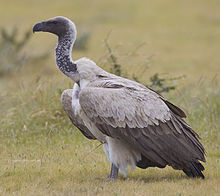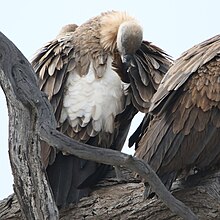
A vulture is a bird of prey that scavenges on carrion. There are 23 extant species of vulture. Old World vultures include 16 living species native to Europe, Africa, and Asia; New World vultures are restricted to North and South America and consist of seven identified species, all belonging to the Cathartidae family. A particular characteristic of many vultures is a bald, unfeathered head. This bare skin is thought to keep the head clean when feeding, and also plays an important role in thermoregulation.

Old World vultures are vultures that are found in the Old World, i.e. the continents of Europe, Asia and Africa, and which belong to the family Accipitridae, which also includes eagles, buzzards, kites, and hawks.

The Eurasian griffon vulture is a large Old World vulture in the bird of prey family Accipitridae. It is also known as the Griffon vulture, although this term is sometimes used for the genus as a whole. It is not to be confused with the Rüppell's griffon vulture and Himalayan griffon vulture. It is closely related to the white-backed vulture.
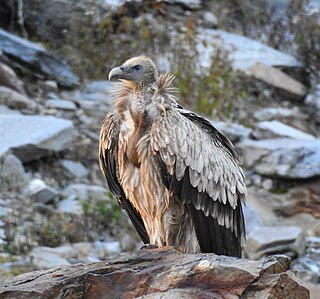
The Himalayan vulture or Himalayan griffon vulture is an Old World vulture native to the Himalayas and the adjoining Tibetan Plateau. It is one of the two largest Old World vultures and true raptors. It is listed as Near Threatened on the IUCN Red List. It is not to be confused with the Eurasian griffon vulture, which is a similar and sympatric species.

The white-rumped vulture is an Old World vulture native to South and Southeast Asia. It has been listed as Critically Endangered on the IUCN Red List since 2000, as the population severely declined. White-rumped vultures die of kidney failure caused by diclofenac poisoning. In the 1980s, the global population was estimated at several million individuals, and it was thought to be "the most abundant large bird of prey in the world". As of 2021, the global population was estimated at less than 6,000 mature individuals.
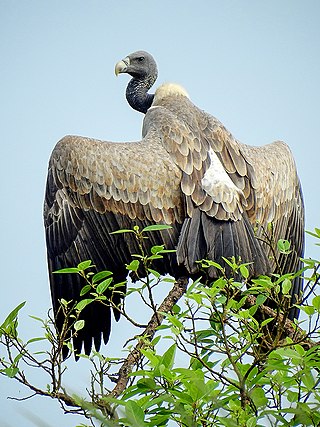
The Indian vulture or long-billed vulture is a bird of prey native to the Indian subcontinent. It is an Old World vulture belonging to the family of Accipitridae. It is a medium-sized vulture with a small, semi-bald head with little feathers, long beak, and wide dark colored wings. It breeds mainly on small cliffs and hilly crags in central India and south India.

The hooded vulture is an Old World vulture in the order Accipitriformes, which also includes eagles, kites, buzzards and hawks. It is the only member of the genus Necrosyrtes, which is sister to the larger Gyps genus, both of which are a part of the Aegypiinae subfamily of Old World vultures. It is native to sub-Saharan Africa, where it has a widespread distribution with populations in southern, East and West Africa. It is a scruffy-looking, small vulture with dark brown plumage, a long thin bill, bare crown, face and fore-neck, and a downy nape and hind-neck. Its face is usually a light red colour. It typically scavenges on carcasses of wildlife and domestic animals. Although it remains a common species with a stable population in the lower region of Casamance, some areas of The Gambia, and Guinea-Bissau, other regions such as Dakar, Senegal, show more than 85% losses in population over the last 50 years. Threats include poisoning, hunting, loss of habitat and collisions with electricity infrastructure, and the International Union for Conservation of Nature has rated its conservation status as "critically endangered" in their latest assessment (2022). The highest current regional density of hooded vultures is in the western region of The Gambia.

The lappet-faced vulture or Nubian vulture is an Old World vulture belonging to the bird order Accipitriformes, which also includes eagles, kites, buzzards and hawks. It is the only member of the genus Torgos. It is not closely related to the superficially similar New World vultures, and does not share the good sense of smell of some members of that family of birds.

The cinereous vulture is a large raptor in the family Accipitridae and distributed through much of temperate Eurasia. It is also known as the black vulture, monk vulture and Eurasian black vulture. With a body length of 1.2 m, 3.1 m (10 ft) across the wings and a maximum weight of 14 kg (31 lb), it is the largest Old World vulture and largest member of the Accipitridae family.

Rüppell's vulture, also called Rüppell's griffon vulture, named after Eduard Rüppell, is a large bird of prey, mainly native to the Sahel region and East Africa. The former population of 22,000 has been decreasing due to loss of habitat, incidental poisoning, and other factors. Known also as Rüppell's griffon, Rueppell's griffon, Rüppell's griffin vulture, Rueppell's vulture and other variants, it is not to be confused with a different species, the griffon vulture. Rüppell's vulture is considered to be the highest-flying bird, with confirmed evidence of a flight at an altitude of 11,300 m (37,000 ft) above sea level.

The tawny eagle is a large bird of prey. Like all eagles, it belongs to the family Accipitridae. Its heavily feathered legs mark it as a member of the subfamily Aquilinae, also known as booted eagles. Tawny eagles have an extensive but discontinuous breeding range that constitutes much of the African continent as well as the Indian subcontinent, with rare residency in the southern Middle East. Throughout its range, it favours open dry habitats such as semideserts, deserts steppes, or savanna plains. Despite its preference for arid areas, the species seldom occurs in areas where trees are entirely absent. It is a resident breeder which lays one to three eggs in a stick nest most commonly in the crown of a tree. The tawny eagle is perhaps the most highly opportunistic of all Aquilinae, and often scavenges on carrion or engages in kleptoparasitism towards other carnivorous animals but is also a bold and active predator, often of relatively large and diverse prey. It is estimated that tawny eagles can reach the age of 16 years old. Nonetheless, precipitous declines have been detected throughout the tawny eagle's range. Numerous factors, particularly loss of nesting habitat due to logging and global warming, as well as persecution and other anthropogenic mortality are driving the once numerous tawny eagle perhaps to the brink of extinction.

The Cape vulture, also known as Cape griffon and Kolbe's vulture, is an Old World vulture in the family Accipitridae. It is endemic to southern Africa, and lives mainly in South Africa, Lesotho, Botswana, and in some parts of northern Namibia. It nests on cliffs and lays one egg per year. In 2015, it had been classified as Endangered on the IUCN Red List, but was down-listed to Vulnerable in 2021 as some populations increased and have been stable since about 2016.
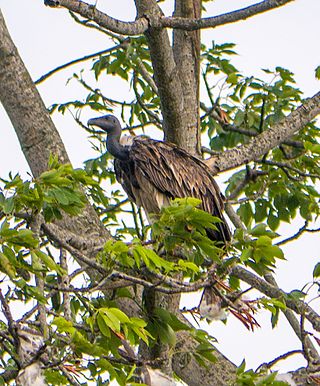
The slender-billed vulture is an Old World vulture species native to sub-Himalayan regions and Southeast Asia. It is Critically Endangered since 2002 as the population on the Indian subcontinent has declined rapidly. As of 2021, fewer than 870 mature individuals are thought to remain.

The red-headed vulture, also known as the Asian king vulture, Indian black vulture or Pondicherry vulture, is an Old World vulture mainly found in the Indian subcontinent, with small disjunct populations in some parts of Southeast Asia.

The bateleur is a medium-sized eagle in the family Accipitridae. It is often considered a relative of the snake eagles and, like them, it is classified within the subfamily Circaetinae. It is the only member of the genus Terathopius and may be the origin of the "Zimbabwe Bird", the national emblem of Zimbabwe. Adult bateleurs are generally black in colour with a chestnut colour on the mantle as well as also on the rump and tail. Adults also have gray patches about the leading edges of the wings with bright red on their cere and their feet. Adults also show white greater coverts, contrasting with black remiges in males, gray patches on the underwing primaries and black wingtips. The juvenile bateleur is quite different, being largely drab brown with a bit of paler feather scaling. All bateleurs have extremely large heads for their size, rather small bills, large feet, relatively short legs, long, bow-like wings and uniquely short tails, which are much smaller still on adults compared to juvenile birds.

The white-headed vulture is an Old World vulture endemic to Africa. Populations have been declining steeply in recent years due to habitat degradation and poisoning of vultures at carcasses. An extinct relative was also present in the Indonesian island of Flores during the Late Pleistocene, indicating that the genus was more widespread in the past.

Nine species of vulture can be found living in India, but most are now in danger of extinction after a rapid and major population collapse in recent decades. In the early 1980s, three species of Gyps vultures had a combined estimated population of 40 million in South Asia, while in 2017 the total population numbered only 19,000.

The Jatayu and Sparrow Conservation Breeding Centre (JCBC), is the world's largest facility for the breeding and conservation of Indian vultures and the house sparrow. It is located within the Bir Shikargah Wildlife Sanctuary in the town of Pinjore in the State of Haryana, India. It is run by the Haryana Forests Department and Bombay Natural History Society with the help of British nature conservation charity Royal Society for the Protection of Birds. It is 8 kilometres (5.0 mi) from Pinjore and covers 5 acres (2.0 ha).
A vulture restaurant is a site where carrion, decaying flesh from dead animals, is deposited in order to be consumed by vultures, and is sometimes referred to more generally as supplemental feeding or provisioning. These stations can also be referred to as vulture feeding sites, vulture feeding stations, and vulture safe zones. This supplemental feeding practice is used to provide vultures with reliable, non-contaminated food sources or to aid in monitoring schemes. Vulture restaurants have been instituted as a method of vulture conservation in Europe and Africa since the 1960's and 70's, when vulture populations began to decline. This strategy is used because often population declines are attributed to low food availability, food contamination or insufficient nutritional quality, or feeding from human areas leading to conflict. Notably, large vulture population declines in South Asia, referred to as the Asian or Indian vulture crisis, and Africa, referred to as the African vulture crisis, have brought renewed attention to the uses and impacts of vulture restaurants. Vulture restaurants are used in Asia, Africa, Europe, and North America for various conservation and management plans. They can help combat food-derived threats to vultures, such as diclofenac or lead contamination or conflict with ranchers and poachers. The first vulture restaurant was built in South Africa in 1966. Vulture restaurants operate in a number of countries, including Nepal, India, Cambodia, South Africa, Eswatini, and Spain.
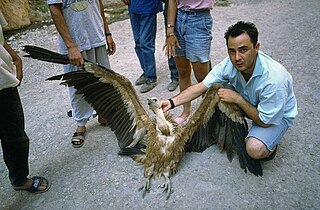
The African vulture crisis is the name given to the ongoing population decline in several Old World vulture species across Africa. Steep population declines have been reported from many locations across the continent since the early 2000s. The causes are mainly poisoning from baited animal carcasses, and the illegal trade in vulture body parts for traditional medicine. Available data suggest that the African vulture crisis may be similar in scale to the Indian vulture crisis, but more protracted and less well documented.
